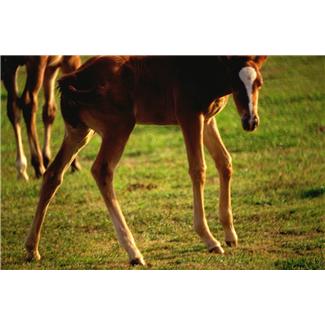White Line Disease in Horses
The hooves are the most used parts of a horse's body. They are
ever vulnerable to the wear, tear, and various other fatal infections.
One such fungal infection is the White Line disease. It is also known as
Hollow Foot, Seedy Toe, and Wall Thrush. Medically, the White Line
disease is termed as Onychomycosis (Latin: onyx means nail, myke means
fungus, and osis means condition).
Description of the Disease
The
hoof wall has 3 layers - external, middle, & internal. External
wall forms the outer covering. The middle layer consists of the horn
tubules providing speed and elasticity to the hoof. The internal layer
consists of 600 tissue extensions, interlocked with the sensitive lamina
called stratum lamellatum. This lamina protects the coffin bone,
sensitive cartilages, and the other sensitive parts of the hoof. White
Line or Zona Lamellatum is the junction between the hoof wall and the
sole. The bacteria or fungi attack the horn tubules, which are distant
from the blood vessels. This sets in the infection. Consequently, the
hoof wall is separated from the sensitive lamina resulting in:
- The reduction of weight support between the hoof & the hoof wall
- The other hoof complications, like bulging, swelling, etc.
Causes
The
bacterial or fungal infection attacks through a crack or a fissure in
the hoof. The hot and humid environment allows the fungi to survive for
long, causing more damage, like:
- Tear in the medium layer from Laminitis
- Acute trauma from forward extended toes, which causes lamina tissues to extend and become unhealthy
- Sole or toe bruising adjacent to the white line, causing blood clots
- Loss of shoe
- Improper trimming
- Poor nutrition
Symptoms
- Separation between the hoof and the sole
- Partial removal of the hoof
- Tenderness or flattening in the sole
- A hollow sound of the hoof
Diagnosis
The disease is diagnosed with the help of X-ray examination.
Treatment
- The affected external layer or the outer hoof wall is removed to expose the wound fully to light & air
- Damaged tissues are removed fortnightly until a solid junction forms between the lamina & the hoof wall
- Medicines like Betadine, fungi dye, merthiolate, etc., can be applied to the wound.
- Metallic shoes are used to bandage or protect the affected hooves. The shoes are screwed to the outer hoof wall.
Precautions
- Timely hoof care
- Employing the soaks of Clorox, copper sulfate, etc.
- Ensuring enough sunlight & cleanliness in the stable or ranches
- Disinfection of the trimming instruments
- Proper nutrition of the horse



Comments
Post a Comment